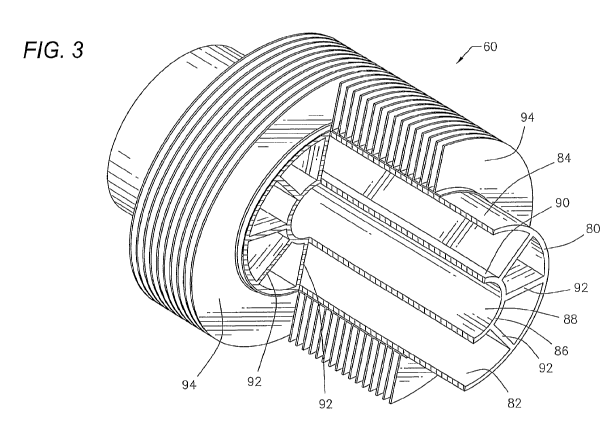Une partie des informations de ce site Web a été fournie par des sources externes. Le gouvernement du Canada n'assume aucune responsabilité concernant la précision, l'actualité ou la fiabilité des informations fournies par les sources externes. Les utilisateurs qui désirent employer cette information devraient consulter directement la source des informations. Le contenu fourni par les sources externes n'est pas assujetti aux exigences sur les langues officielles, la protection des renseignements personnels et l'accessibilité.
L'apparition de différences dans le texte et l'image des Revendications et de l'Abrégé dépend du moment auquel le document est publié. Les textes des Revendications et de l'Abrégé sont affichés :
| (12) Demande de brevet: | (11) CA 2727359 |
|---|---|
| (54) Titre français: | TUBE D'ECHANGEUR DE CHALEUR AMELIORE ET REFROIDISSEUR INTERMEDIAIRE AIR-AIR |
| (54) Titre anglais: | IMPROVED HEAT EXCHANGER TUBE AND AIR-TO-AIR INTERCOOLER |
| Statut: | Morte |
| (51) Classification internationale des brevets (CIB): |
|
|---|---|
| (72) Inventeurs : |
|
| (73) Titulaires : |
|
| (71) Demandeurs : |
|
| (74) Agent: | DEETH WILLIAMS WALL LLP |
| (74) Co-agent: | |
| (45) Délivré: | |
| (86) Date de dépôt PCT: | 2009-06-09 |
| (87) Mise à la disponibilité du public: | 2010-04-01 |
| Licence disponible: | S.O. |
| (25) Langue des documents déposés: | Anglais |
| Traité de coopération en matière de brevets (PCT): | Oui |
|---|---|
| (86) Numéro de la demande PCT: | PCT/US2009/046735 |
| (87) Numéro de publication internationale PCT: | WO2010/036421 |
| (85) Entrée nationale: | 2010-12-09 |
| (30) Données de priorité de la demande: | ||||||
|---|---|---|---|---|---|---|
|
Cette invention concerne un tube déchangeur de chaleur amélioré et un refroidisseur intermédiaire air-air ou autres échangeurs de chaleur air-air. Le tube de refroidissement comporte un premier et un second tubes présentant chacun une surface intérieure et une surface extérieure. Le second tube est logé dans le premier tube. Une ou plusieurs cloisons relient la surface intérieure du premier tube à la surface extérieure du second tube. Une pluralité dailettes est disposée sur la surface extérieure du premier tube. Ces ailettes peuvent prendre la forme dailettes individuelles circulaires, ou bien dune ou de plusieurs ailettes hélicoïdales.
An improved heat exchanger tube which can be used in an air-to-air intercooler
or other air-to-air heat exchangers.
The cooling tube has a first tube with an inner and outer surface and a second
tube with an inner and outer surface. The second
tube is located inside the first tube. There are one or more walls extending
from the inner surface of the first tube to the outer
surface of the second tube. A plurality of fins are located on the outer
surface of the first tube. The fins can take the form of
individual circular fins or one or more helical fins.
Note : Les revendications sont présentées dans la langue officielle dans laquelle elles ont été soumises.
Note : Les descriptions sont présentées dans la langue officielle dans laquelle elles ont été soumises.

Pour une meilleure compréhension de l'état de la demande ou brevet qui figure sur cette page, la rubrique Mise en garde , et les descriptions de Brevet , États administratifs , Taxes périodiques et Historique des paiements devraient être consultées.
| Titre | Date |
|---|---|
| Date de délivrance prévu | Non disponible |
| (86) Date de dépôt PCT | 2009-06-09 |
| (87) Date de publication PCT | 2010-04-01 |
| (85) Entrée nationale | 2010-12-09 |
| Demande morte | 2015-06-09 |
| Date d'abandonnement | Raison | Reinstatement Date |
|---|---|---|
| 2014-06-09 | Absence de requête d'examen | |
| 2014-06-09 | Taxe périodique sur la demande impayée |
| Type de taxes | Anniversaire | Échéance | Montant payé | Date payée |
|---|---|---|---|---|
| Le dépôt d'une demande de brevet | 400,00 $ | 2010-12-09 | ||
| Taxe de maintien en état - Demande - nouvelle loi | 2 | 2011-06-09 | 100,00 $ | 2011-05-31 |
| Taxe de maintien en état - Demande - nouvelle loi | 3 | 2012-06-11 | 100,00 $ | 2012-06-01 |
| Taxe de maintien en état - Demande - nouvelle loi | 4 | 2013-06-10 | 100,00 $ | 2013-05-30 |
Les titulaires actuels et antérieures au dossier sont affichés en ordre alphabétique.
| Titulaires actuels au dossier |
|---|
| GEA RAINEY CORPORATION |
| Titulaires antérieures au dossier |
|---|
| S.O. |